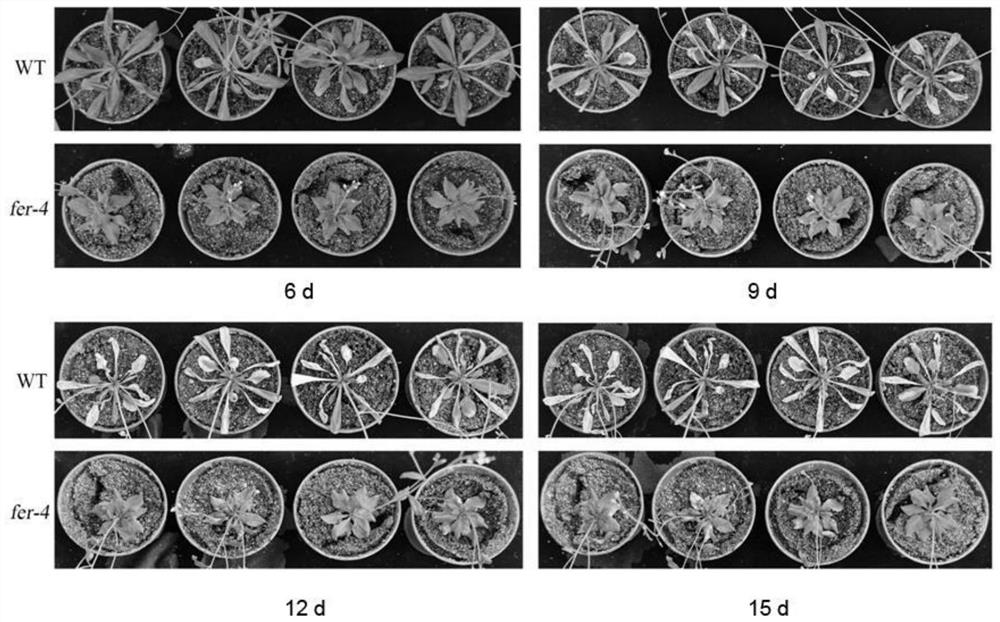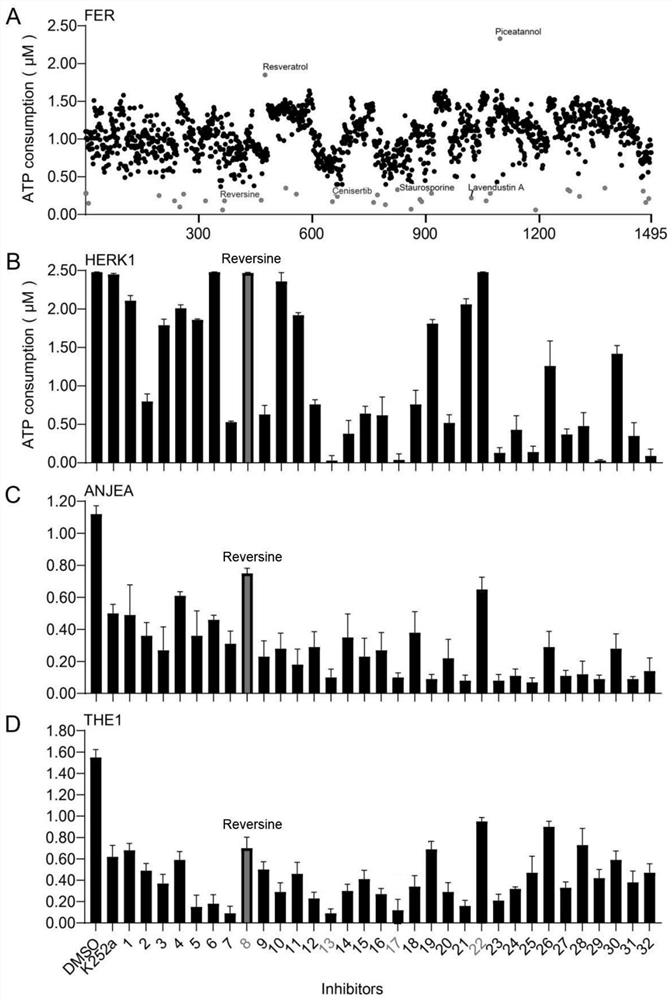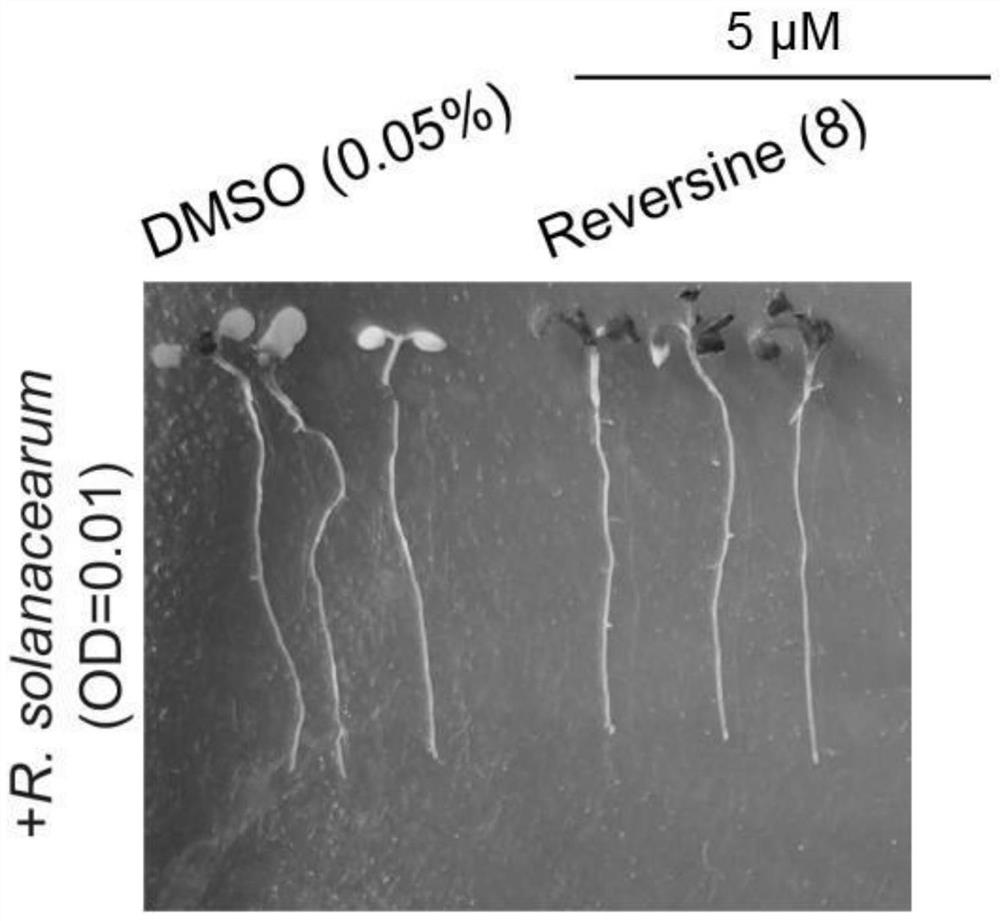Application of kinase inhibitor Reversine in improving bacterial wilt resistance of plants
A kinase inhibitor, bacterial wilt technology, applied in the direction of application, plant growth regulator, plant growth regulator, etc., to achieve the effect of improving resistance
- Summary
- Abstract
- Description
- Claims
- Application Information
AI Technical Summary
Problems solved by technology
Method used
Image
Examples
Embodiment 1
[0024] Ralstonia solanacearum CQPS strain was shaken overnight at 28°C (the strain was derived from the literature Genome sequencing of Ralstonia solanacearum CQPS-1, a phylotype I strain collected from a highlandarea with continuous cropping of tobacco), and the OD 600 After adjusting to 0.1, inoculate the roots of Arabidopsis wild-type WT and FER loss-of-function mutant fer-4 grown for 4 weeks, and water each plant with 30 mL of R. solanacearum solution to inoculate the same amount of dd H 2 O plants were used as blank control and cultured under long-day light at 28°C. Water once a day, observe and record the development of the disease of plant bacterial wilt, figure 1 In order to inoculate the 6-15d plants with disease, Arabidopsis wild-type WT developed bacterial wilt disease over time, while the FER loss-of-function mutant fer-4 grew normally and had no bacterial wilt disease.
Embodiment 2
[0026] Based on prokaryotic expression protein technology, the prokaryotic expression vector of FER gene was constructed, and the FER intracellular domain protein was obtained by in vitro purification. The specific operation steps are as follows:
[0027] PCR cloning: PCR reaction amplifies the FER gene fragment. PCR reaction system (50 μL);
[0028] Table 1 Components of PCR reaction system
[0029]
[0030] PCR reaction conditions: pre-denaturation at 95°C for 5 min; denaturation at 95°C for 30 s, annealing at 60°C for 30 s, extension at 72°C for 30 s, after 34 cycles, extension at 72°C for 10 min, and storage at 4°C after completion. PCR product recovery: The PCR product of FER was recovered by gel and stored at 4°C. The primers for PCR amplification of FER are His-FER-F / His-FER-R, and the primer sequences are as follows:
[0031] His-FER-F
[0032] 5'-CCACAGCCA GGATCC GGGTGCTTACCGCAGACGTA-3' (the underline is the restriction site of BamH I)
[0033] His-FER-R
...
Embodiment 3
[0037] Screening of chemical inhibitors of FER kinase activity: Prokaryotic expression and purification of the intracellular domain protein of FER after ultrafiltration, using Kinase-Lumi TM Chemiluminescent Kinase Activity Detection Kit (Beiyuntian, China) was used to detect FER autophosphorylation activity according to the instructions. In the kinase system containing 0.5 μM FER (containing 50 mM HEPES, 10 mM MgCl2, 10 mM nCl2, 1 mM EGTA, pH=7.48), add a final concentration of 5 μM inhibitor (from the kinase inhibitor library purchased from Shanghai MedChemExpress) for 30 min at room temperature, Use the inhibitor solvent DMSO (0.05%) as a negative control, then add ATP at a final concentration of 0.25 μM to react for 10 minutes, and finally add a detection reagent containing ATP-dependent luciferase equal to the volume of the reaction system to react for 10 minutes and pass the multifunctional enzyme label instrument for chemiluminescence measurements. The amount of ATP co...
PUM
 Login to View More
Login to View More Abstract
Description
Claims
Application Information
 Login to View More
Login to View More - R&D Engineer
- R&D Manager
- IP Professional
- Industry Leading Data Capabilities
- Powerful AI technology
- Patent DNA Extraction
Browse by: Latest US Patents, China's latest patents, Technical Efficacy Thesaurus, Application Domain, Technology Topic, Popular Technical Reports.
© 2024 PatSnap. All rights reserved.Legal|Privacy policy|Modern Slavery Act Transparency Statement|Sitemap|About US| Contact US: help@patsnap.com










